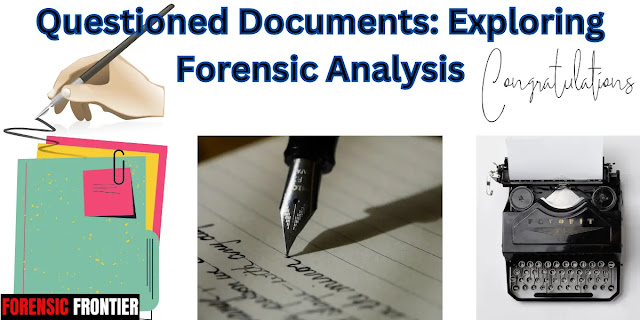Questioned Documents: Exploring Forensic Analysis
Introduction:
In the intricate web of
business transactions and written communication, documents play a paramount
role. As our society relies heavily on these written records, the field of
forensic document examination, often known as "questioned documents,"
has gained significant importance. This discipline, closely linked with
white-collar crimes, involves scrutinizing documents that are potentially
disputed within legal proceedings. Through the application of scientific
principles and methods, questioned document examination aims to furnish
evidence regarding dubious or contested documents. This encompasses a spectrum
of analyses such as alterations, obliterations, paper composition, forgery
detection, origin determination, authenticity validation, and more. However, the
practical application of this forensic science extends beyond financial crimes
and can encompass diverse cases, ranging from medical malpractice to forgeries
to even homicides. Astonishingly, around 70% of physical evidence in cases
relates to disputed documents, highlighting its pervasive relevance. The range
of potential evidence includes various forms of writing encountered during
investigations.
Evolution with Technology:
Empowered by sophisticated
technology, forensic document examiners wield the ability to delve into both
visible and concealed marks on documents, extracting a wealth of information
that can either substantiate authenticity or yield critical insights pivotal to
investigations. In the digital age, the significance of their work has surged
even higher. The proliferation of potent software tools like Adobe Photoshop
and Acrobat has significantly eased the process for criminals to fabricate and
manipulate an array of fraudulent documents—spanning contracts to currency.
The Essence of Documents:
A document, in essence,
encompasses any material imbued with marks, symbols, or signs—be they visibly
apparent or partially concealed—conveying meaning to a recipient. These
manifestations can range from pencil scribbles, inked writing, and typewritten
text, to printed content on paper.
Decoding Questioned Documents:
Definition: A
"questioned document" encompasses any document or object bearing
handwritten, typewritten, or printed markings, where doubts loom over its
source or authenticity, thus subjecting it to scrutiny. This comprehensive
characterization encapsulates the entirety of written and printed materials we
routinely encounter in our daily, social, and business interactions.
Unveiling the Complexity:
For instance, consider a case
involving a disputed will. The authenticity of the deceased's signature comes
under question, prompting a forensic document examiner to meticulously analyze
the signature's stroke patterns, pressure points, and overall consistency. By
comparing this questioned signature with authentic samples from the deceased,
the examiner can ascertain whether the signature is genuine or a forgery,
potentially unravelling a legal puzzle with far-reaching consequences.
conclusion:
In conclusion, the realm of
questioned documents stands as a critical pillar in the edifice of forensic
science. It bridges the gap between the tangible world of documents and the
realm of justice, unravelling intricate mysteries and unveiling hidden truths.
As technology continues to advance, the tools and techniques available to
forensic document examiners will only become more potent, reinforcing their
role in upholding the integrity of written records and the pursuit of truth.




.webp)


.webp)
.webp)
.webp)
.webp)
.webp)
.webp)

.webp)
.webp)

0 Comments
If you have any doubts, let me know.